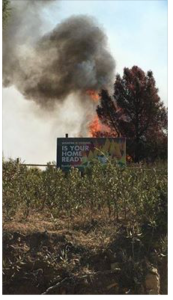As the Loma wildfire rages in the Santa Cruz Mountains this week, threatening homes and residents, we here in the East Bay are quickly approaching the 25th anniversary of the Oakland Hills Fire. Many of you may remember that tragic day on October 19, 2001 when a brush fire driven by strong northeasterly winds, burned more than 1,500 acres over three days, killing 25 people and destroying over 2,500 homes and 400 apartments.

Photo with permission from Chico Fire Rescue
Long time Berkeley resident and Realtor at Berkeley Hills Realty, Maya Trilling remembers the day the Oakland Hills fire broke out. “Before the fire even started, and because of high winds that day, I remember saying it was dangerous to go outside that day.”
The danger came from the luxuriant trees and shrubs—mostly decorative non-native “exotics”—that made homeowners yards so pleasing, were also highly flammable, and often grew right against the walls and eaves of the homes.
A recent California Magazine article stated, “In retrospect, one of the most disturbing things about the Oakland Hills fire was that so few people had recognized the imminent danger.”
“North and south of the fire perimeter, it’s basically like it was in 1991,” says Scott Stephens, a professor in the Department of Environmental Science, Policy and Management and one of the West’s foremost wildfire researchers. “There are very heavy fuel loads right next to homes and other structures. The bottom line is that the fire hazard in the East Bay Hills remains very high to extreme.”
With recent drought and high temperatures around the Bay Area, now is the time to think about fire safety.
When you decide to purchase a home on the hillsides of the East Bay, you need to understand defensible space, which plants to keep around your house, your escape routes and more.
CalFire offers a seasonal chart of what homeowners can do to reduce wildfire risk. Here is what they suggest for the Autumn:
If planting trees, wait until the weather cools and fall rains have increased soil moisture.
Now is one of the best times to remove dead and dying trees, and dense undergrowth.
Water high-value trees only if significantly less than average rainfall this season; otherwise, do not water.
See the chart at http://www.readyforwildfire.org/Seasonal-Actions/
CalFire also provides tips on evacuation:
Long Before a Fire Threatens
Prepare an Evacuation Checklist and Organize:
▪ Critical medications.
▪ Important personal papers, photos.
▪ Essential valuables.
▪ Pet and livestock transport, limited amount of pet food.
▪ Change of clothing, toiletries.
▪ Cell phone.
▪ Critical papers and effects in a re-proof safe.
▪ An Evacuation Route Map with at least two routes.*
Drive your planned route of escape before an actual emergency.*
During an evacuation, law enforcement/ emergency personnel may determine your route.
Vegetation Management
The Audubon Society, the California Native Plant Society, and the Claremont Conservancy designed an ecologically- and fiscally-sustainable model for fire management that not only reduces the risk of fires, but also promotes diverse and healthy ecosystems. This strategy entails removing flammable, ember-generating species like eucalyptus in phases — and only in select areas considered most at risk for fire along the urban-wild interface — so that less flammable natives can reclaim those areas and allow a rebound of biodiversity.
The Sierra Club’s program for vegetation management can be summarized as the “Three R’s”:
Remove the most flammable non-native plant species in select areas considered most at risk for fire along the urban-wild interface of the East Bay hills;
Restore those areas with more naturally fire-resistant native trees like bays, oaks, laurels, and native grasslands; and
Re-establish greater biodiversity of flora and fauna, including endangered species like the Alameda whipsnake.
History has a way of repeating itself when people forget. Although it has been 25 years since the tragic firestorm in the Oakland Hills, we can see by what is happening in the Santa Cruz Mountains, that diligence is needed to avoid another tragedy closer to home.
For more information about fire safetly, visit the CalFire website: http://calfire.ca.gov
Berkeley Hills Realty cares about our community! Please be fire safe!
Comments